Student Assessment - Purpose, Instructions, Conditions, Outcome
Added on 2023-06-10
29 Pages6415 Words288 Views
Student Assessment
Cover Sheet
Student ID Student Name Teacher Name
Assessment Requirements
Unit Details
Unit Code(s) Unit Title(s)
TAEDES401 Design and develop learning programs
TAEDES402 Use training packages and accredited
courses to meet client needs
Assessment Task
Task No# Assessment Method and Type
KQ Questioning ☒ Written 3/4/22
Extension Details (where applicable)
Extension Date for Submission Granted
Until
STUDENT
DECLARATION
This is my
own work.
I am aware
that penalties
exist for
breaches of
academic
misconduct.
Refer to the
Behaving
with
Academic
Integrity and
Penalties for
Academic
Misconduct
pages.
I have a copy
of this
assessment
STUDENT
SIGNATURE: You must sign here DATE: Date of your
submission
For electronic
submissions only:
By typing your
name in the student
signature field, you
are accepting the
above declaration.
Unit Details
Code(s) Title(s)
TAEDES401 Design and develop learning programs
TAEDES402 Use training packages and accredited courses to meet client
needs
Assessment Task Details
Task No# Assessment Method Type
KQ Questioning ☒ Written
Cover Sheet
Student ID Student Name Teacher Name
Assessment Requirements
Unit Details
Unit Code(s) Unit Title(s)
TAEDES401 Design and develop learning programs
TAEDES402 Use training packages and accredited
courses to meet client needs
Assessment Task
Task No# Assessment Method and Type
KQ Questioning ☒ Written 3/4/22
Extension Details (where applicable)
Extension Date for Submission Granted
Until
STUDENT
DECLARATION
This is my
own work.
I am aware
that penalties
exist for
breaches of
academic
misconduct.
Refer to the
Behaving
with
Academic
Integrity and
Penalties for
Academic
Misconduct
pages.
I have a copy
of this
assessment
STUDENT
SIGNATURE: You must sign here DATE: Date of your
submission
For electronic
submissions only:
By typing your
name in the student
signature field, you
are accepting the
above declaration.
Unit Details
Code(s) Title(s)
TAEDES401 Design and develop learning programs
TAEDES402 Use training packages and accredited courses to meet client
needs
Assessment Task Details
Task No# Assessment Method Type
KQ Questioning ☒ Written
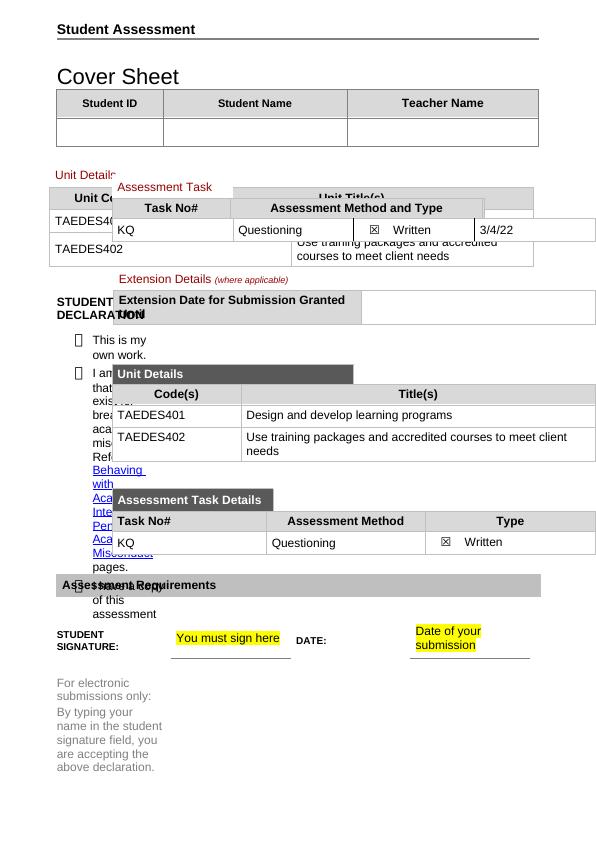
Student Assessment
Purpose of the task:
This holistic assessment addresses components of two units of competency. It gathers evidence of required
knowledge to:
conceptualise, design, develop and review learning programs to meet an identified need for a group
of learners
identify the parameters of a learning program, determine its design, outline the content, and review
its effectiveness
use training packages and accredited courses as tools to support industry, organisation and
individual competency development needs.
Instructions: Read requirements for satisfactory completion and answer questions in full.
Purpose of the task:
This holistic assessment addresses components of two units of competency. It gathers evidence of required
knowledge to:
conceptualise, design, develop and review learning programs to meet an identified need for a group
of learners
identify the parameters of a learning program, determine its design, outline the content, and review
its effectiveness
use training packages and accredited courses as tools to support industry, organisation and
individual competency development needs.
Instructions: Read requirements for satisfactory completion and answer questions in full.
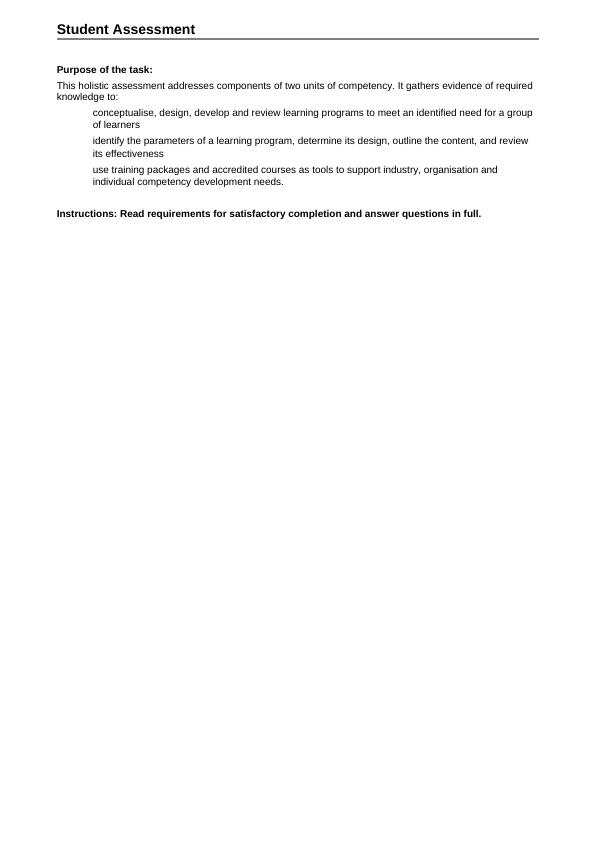
Student Assessment
You must answer all questions to a satisfactory standard. For a satisfactory result:
● submit typed (not hand-written) responses
● respond using complete sentences, making direct reference to the question
● responses are correct, and cover all parts of each question
● respond using your own words—when occasionally quoting information from another source, you
must acknowledge that source
● each numbered response is about 200-250 words long—this is an average only; some questions will
require longer responses, some shorter
● your responses match instructions provided about terminology (see below)
Terminology used in the questions—how to respond
If you are asked to ▼ You should ▼
List In bulleted, numbered or paragraph form, provide a number of consecutive items—if paragraph
form, use commas (,) to separate items
Describe In paragraph form, give a full account of an event, idea or concept—include all relevant
circumstances and details.
Explain In paragraph form, describe—in enough detail to clarify or justify—an idea, concept, situation,
action taken, insight or challenge.
Define In paragraph form, explain the meaning of a term or concept—use your own words to define the term
or concept, or quote an accurate, published definition (in this case, note the source).
Summarise In paragraph or list form, explain the key points or insights derived from a text, event or situation.
Compare List, describe or explain the similarities and differences between two (or more) ideas, concepts,
events, situations, challenges or insights.
Assessment Conditions
Your project must be submitted in the format requested and on time.
Location and environment: You will complete this assessment in both a structured classroom environment,
and as a self-directed task.
Resources: This is an open book assessment where you can use your learning materials as a reference.
Authenticity: It must your own individual work and written in your own words. When quoting specific
references, you must acknowledge the source. Evidence of plagiarism or cheating will result in the
assessment being assessed as unsatisfactory and a further investigation will occur.
Resources and Equipment Required
You will need to provide:
A computer and the Internet (if completing out of class hours)
The assessor will provide:
The assessment task cover sheet either in hard copy or electronically in Canvas
Access to classroom
Access to computer and the Internet
Access to applicable legislation, industry codes of practice, regulations as required
You must answer all questions to a satisfactory standard. For a satisfactory result:
● submit typed (not hand-written) responses
● respond using complete sentences, making direct reference to the question
● responses are correct, and cover all parts of each question
● respond using your own words—when occasionally quoting information from another source, you
must acknowledge that source
● each numbered response is about 200-250 words long—this is an average only; some questions will
require longer responses, some shorter
● your responses match instructions provided about terminology (see below)
Terminology used in the questions—how to respond
If you are asked to ▼ You should ▼
List In bulleted, numbered or paragraph form, provide a number of consecutive items—if paragraph
form, use commas (,) to separate items
Describe In paragraph form, give a full account of an event, idea or concept—include all relevant
circumstances and details.
Explain In paragraph form, describe—in enough detail to clarify or justify—an idea, concept, situation,
action taken, insight or challenge.
Define In paragraph form, explain the meaning of a term or concept—use your own words to define the term
or concept, or quote an accurate, published definition (in this case, note the source).
Summarise In paragraph or list form, explain the key points or insights derived from a text, event or situation.
Compare List, describe or explain the similarities and differences between two (or more) ideas, concepts,
events, situations, challenges or insights.
Assessment Conditions
Your project must be submitted in the format requested and on time.
Location and environment: You will complete this assessment in both a structured classroom environment,
and as a self-directed task.
Resources: This is an open book assessment where you can use your learning materials as a reference.
Authenticity: It must your own individual work and written in your own words. When quoting specific
references, you must acknowledge the source. Evidence of plagiarism or cheating will result in the
assessment being assessed as unsatisfactory and a further investigation will occur.
Resources and Equipment Required
You will need to provide:
A computer and the Internet (if completing out of class hours)
The assessor will provide:
The assessment task cover sheet either in hard copy or electronically in Canvas
Access to classroom
Access to computer and the Internet
Access to applicable legislation, industry codes of practice, regulations as required
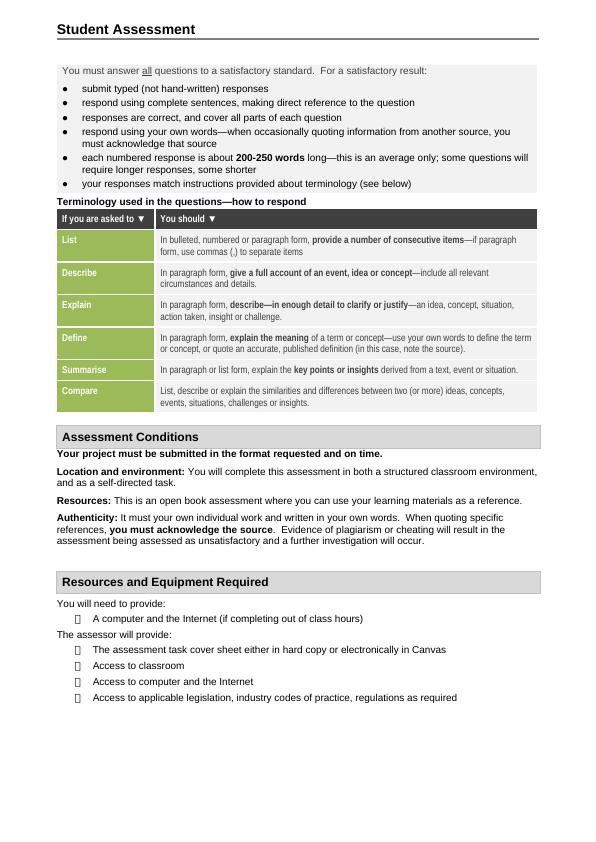
Student Assessment
Resubmission or Re-sit Outcome
Where an answer is deemed unsatisfactory after the first attempt, up to three resubmission or re-sit
attempts will be allowed. The attempt may occur immediately after the assessment if the assessor believes
this is suitable. Alternatively, an additional attempt may be provided at a later stage where the assessor
identifies a need for you to undertake further training and preparation.
The assessor is required to provide you with feedback detailing what was Unsatisfactory (US) and what
you need to do to achieve a Satisfactory (S) outcome using the student feedback record. You will be
required to answer the questions that were incorrect.
Assessment Outcome
To successfully achieve this assessment, you are required to complete all questions correctly to achieve a
Satisfactory (S) outcome.
The outcome of this assessment will contribute to the evidence used in the final decision to achieve
competency for the two units.
Assessment Submission
To meet the requirements of this assessment you will be required to submit the following via Canvas to
your assessor:
Completed Assessment task cover sheet
Completed responses to all questions below plus the templates provided for questions 10, 11, &
12
Other Assessment information (see last page)
Student
Name
Enter your details here: Student ID and here
Written
Questions
Answer the
questions below
(50 – 100 words
each)
1. Explain the vocational education and training (VET) system
a. Explain what VET is and describe its key features
b. Explain what competency-based training (CBT) is and describe its key characteristics.
2. Questions about key VET systems and frameworks
a. Questions about the Australian Qualifications Framework (AQF):
Submission requirements
Vocational education
and training system is
basically a teaching
procedural skills course
and knowledge booster
qualification. With the
help of this system the
person can easily
develop their skills and
abilities so that they can
work effectively in the
future job. They can
pursue any kind as per
their interest and this
training ensures
development of skills in
a wide range of
occupational sector via
work based learning
and school based
learning.
Key features: VET
focuses on practical
knowledge and
experience instead
through hands on
training so that person
can make themselves
ready for doing job
effectively. Hence, it is
said that performance
of student is based on
competence and
motivate them to meet
certain criteria which is
important.
☐ Satisfactory ☐ Unsatisfactory
It is a type of training
which is designed so
that learner can
enhance their abilities
and skills. With the help
of competency based
training, student or any
learner can allow
themselves to be more
proactive beyond their
roles. By learning
various skills they can
achieve their desired
goals which helps them
to develop their
professional skills too.
Key characteristics:
competency based
training improves the
time management
system at learning
environment or any
workplace. It also
allows personalization
which helps learners to
enhance integration
around them at
workplace or learning
place. With the help of
CBT, the learners can
easily explore the
learning opportunities
which helps them to
achieve their goals.
☐ Satisfactory ☐ Unsatisfactory
Resubmission or Re-sit Outcome
Where an answer is deemed unsatisfactory after the first attempt, up to three resubmission or re-sit
attempts will be allowed. The attempt may occur immediately after the assessment if the assessor believes
this is suitable. Alternatively, an additional attempt may be provided at a later stage where the assessor
identifies a need for you to undertake further training and preparation.
The assessor is required to provide you with feedback detailing what was Unsatisfactory (US) and what
you need to do to achieve a Satisfactory (S) outcome using the student feedback record. You will be
required to answer the questions that were incorrect.
Assessment Outcome
To successfully achieve this assessment, you are required to complete all questions correctly to achieve a
Satisfactory (S) outcome.
The outcome of this assessment will contribute to the evidence used in the final decision to achieve
competency for the two units.
Assessment Submission
To meet the requirements of this assessment you will be required to submit the following via Canvas to
your assessor:
Completed Assessment task cover sheet
Completed responses to all questions below plus the templates provided for questions 10, 11, &
12
Other Assessment information (see last page)
Student
Name
Enter your details here: Student ID and here
Written
Questions
Answer the
questions below
(50 – 100 words
each)
1. Explain the vocational education and training (VET) system
a. Explain what VET is and describe its key features
b. Explain what competency-based training (CBT) is and describe its key characteristics.
2. Questions about key VET systems and frameworks
a. Questions about the Australian Qualifications Framework (AQF):
Submission requirements
Vocational education
and training system is
basically a teaching
procedural skills course
and knowledge booster
qualification. With the
help of this system the
person can easily
develop their skills and
abilities so that they can
work effectively in the
future job. They can
pursue any kind as per
their interest and this
training ensures
development of skills in
a wide range of
occupational sector via
work based learning
and school based
learning.
Key features: VET
focuses on practical
knowledge and
experience instead
through hands on
training so that person
can make themselves
ready for doing job
effectively. Hence, it is
said that performance
of student is based on
competence and
motivate them to meet
certain criteria which is
important.
☐ Satisfactory ☐ Unsatisfactory
It is a type of training
which is designed so
that learner can
enhance their abilities
and skills. With the help
of competency based
training, student or any
learner can allow
themselves to be more
proactive beyond their
roles. By learning
various skills they can
achieve their desired
goals which helps them
to develop their
professional skills too.
Key characteristics:
competency based
training improves the
time management
system at learning
environment or any
workplace. It also
allows personalization
which helps learners to
enhance integration
around them at
workplace or learning
place. With the help of
CBT, the learners can
easily explore the
learning opportunities
which helps them to
achieve their goals.
☐ Satisfactory ☐ Unsatisfactory
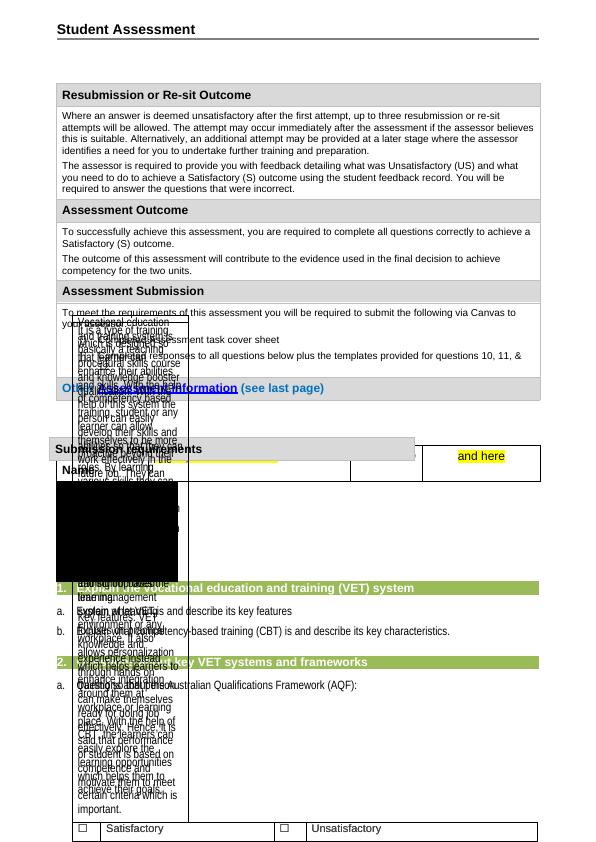
Student Assessment
i. Explain what the AQF is
ii. Describe the purpose of the AQF in Australia’s VET system
iii. Compare the outcomes of an AQF level 3 qualification with a level 5 qualification
AQF is national policy
which is especially
designed by the
government of Australia
to support the learners
in order to ensure that it
will provide an easy
qualification which all
learners have their own
job results and learning
activities.
☐ Satisfactory ☐ Unsatisfactory
The major purpose of
the AQF is to offer an
effective and flexible
and high level of quality
framework that will
provide all the learners
in Australia a good
knowledge and study.
Plus, it provides a
framework for
regulation across the
sectors related to
training, development
and education so that it
will support learners
and enhance mobility of
learners at national and
international level.
☐ Satisfactory ☐ Unsatisfactory
i. Explain what the AQF is
ii. Describe the purpose of the AQF in Australia’s VET system
iii. Compare the outcomes of an AQF level 3 qualification with a level 5 qualification
AQF is national policy
which is especially
designed by the
government of Australia
to support the learners
in order to ensure that it
will provide an easy
qualification which all
learners have their own
job results and learning
activities.
☐ Satisfactory ☐ Unsatisfactory
The major purpose of
the AQF is to offer an
effective and flexible
and high level of quality
framework that will
provide all the learners
in Australia a good
knowledge and study.
Plus, it provides a
framework for
regulation across the
sectors related to
training, development
and education so that it
will support learners
and enhance mobility of
learners at national and
international level.
☐ Satisfactory ☐ Unsatisfactory
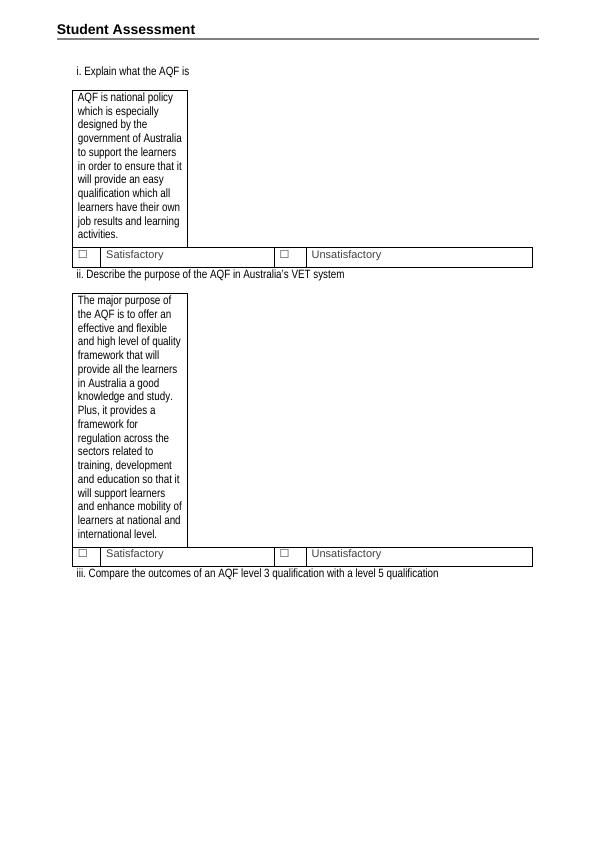
Student Assessment
iv. Explain why trainers and assessors should understand the AQF
In level 3 qualification
the learners will be able
to apply a wide range
of skills, experience,
interest and knowledge
in the workplace.
According to level 3
qualification, the
learners will need at
least 1-2 years to
complete certificate 3
courses. While on the
other side, level 5
qualification is an
advanced diploma
course which allow
learners to have good
knowledge and skills
when they complete the
course. This
qualification provides
high level of
understanding to
students and it takes
slightly less time as
compared to level 3
qualification which is
1.5 years.
☐ Satisfactory ☐ Unsatisfactory
iv. Explain why trainers and assessors should understand the AQF
In level 3 qualification
the learners will be able
to apply a wide range
of skills, experience,
interest and knowledge
in the workplace.
According to level 3
qualification, the
learners will need at
least 1-2 years to
complete certificate 3
courses. While on the
other side, level 5
qualification is an
advanced diploma
course which allow
learners to have good
knowledge and skills
when they complete the
course. This
qualification provides
high level of
understanding to
students and it takes
slightly less time as
compared to level 3
qualification which is
1.5 years.
☐ Satisfactory ☐ Unsatisfactory
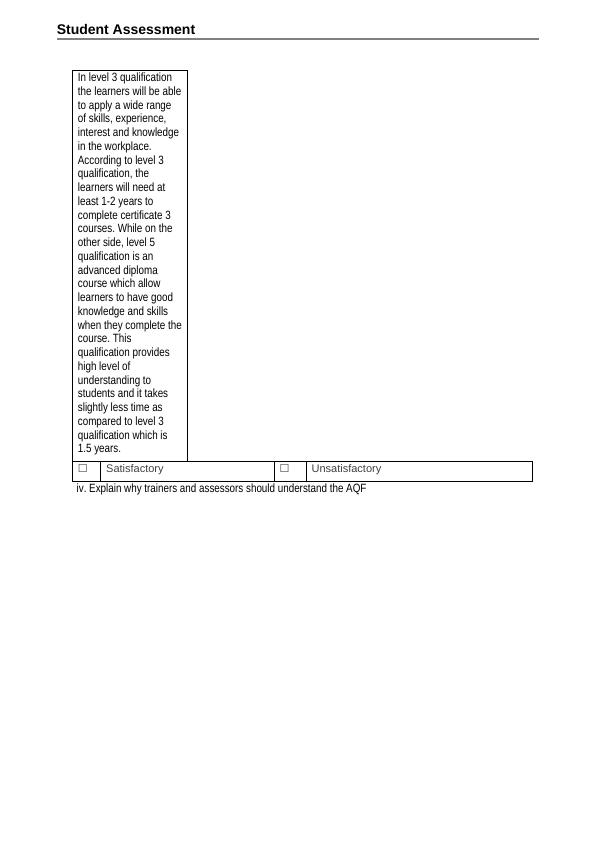
End of preview
Want to access all the pages? Upload your documents or become a member.
Related Documents
Student Assessment for TAEDES401 and TAEDES402lg...
|18
|7259
|354
TAEDES401 & TAEDES402 Learner Workbook - Deskliblg...
|52
|14269
|215
Student Assessment Cover Sheet and Learning Program Designlg...
|25
|5896
|172
Design Competency Based Learning Program - Assessment Tasklg...
|25
|5896
|198
Assessment Task for Ethical Application and Analysis in Diploma of Interpretinglg...
|22
|6722
|59
TAE40116 Certificate IV in Training & Assessment - Knowledge Questions 1A - Designlg...
|54
|11535
|160
